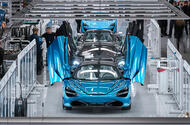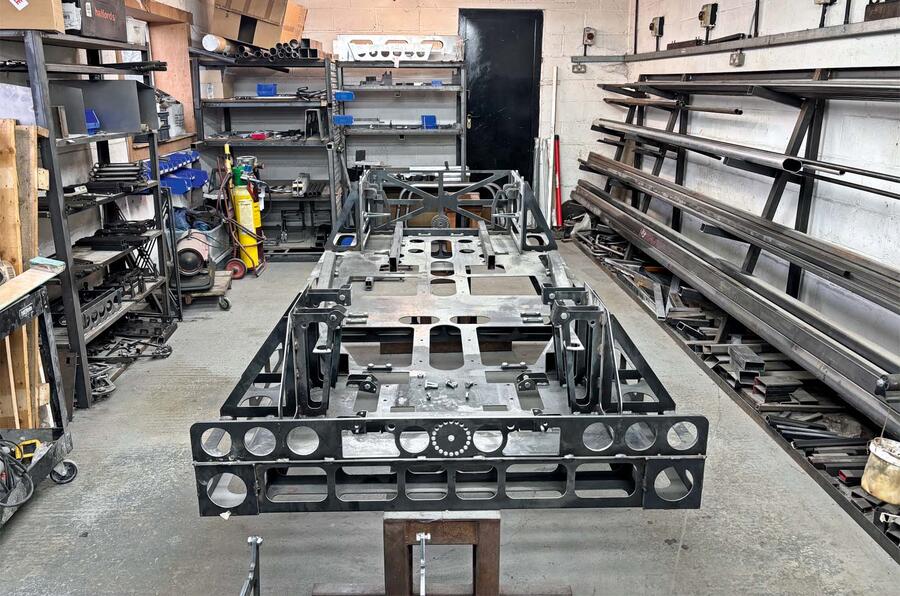Opinion
“McLaren’s Focus on Quality: A Supercar Selling Point | Giga Gears”

Quality team is embedded at every stage of a car's developmentBritish firm wants its quality to be better than Ferrari or Lamborghini's in five years' time
“Quality must be improved.” That was the message repeated constantly by McLaren CEO Michael Leiters on his arrival in Woking in 2022, and in his first interview with us.
It is far from the most exciting topic in the industry yet it’s about as important as it gets: what use is all that thrilling performance if a warning light comes on every five minutes?
The person tasked with delivering for Leiters is an ex-German navy commanding officer.
Jochen Schnez started as chief quality officer in April, not straight from the navy but from Mercedes-Benz, where he spent 21 years after leaving the forces and most recently oversaw the Bremen plant.
Schnez’s time leading a fast patrol boat taught him plenty about “knowing what consequences your decisions will bring with you”. But at Bremen – where high-volume models like the C-Class roll off the line every 60 seconds and more specialised lower volume AMG cars like the GT and SL in as little as 20 seconds – he also honed an appreciation of what a “quality mindset” can bring.
Quality is a word that can mean different things to different people, yet for Schnez it’s simply “meeting or exceeding customer expectations”. It’s not just fit and finish, but all hardware and software working as it should, and cars delivered in the specifications they were ordered in and in full working order.
Ask Schnez where McLaren currently is on its quality ‘journey’ and his diplomatic answer, delivered with a smile, is “you can always improve”, yet he has set the goal of McLarens being at their very best by the end of next year and to be “top of the segment, better than Ferrari or Lamborghini” in five years.
He is in the process of instilling a ‘quality mindset’ at McLaren and its suppliers - a “marathon, not a sprint” into 2026 that will relentlessly emphasise the need for good quality and include company-wide awards and training. He has also built up a quality team of more than 100 people, many of whom are recent recruits from other top car makers such as Porsche, Ferrari and Mercedes.
Schnez’s quality team is embedded throughout the business at every stage of development – not just on the production line but also in design and development teams for both hardware and software.
One key tenet is for parts to be “designed for manufacture” so you don’t create “a world of pain” by handing over a part to the factory that cannot be made at scale in a quality, repeatable way.
This is part of a ‘quality loop’ that stops faults as far upstream as possible and prevents a quality issue from being handed onto the next stage of development or production. “Passing on zero faults is the ultimate goal,” says Schnez. “The aim is always to produce quality, not to check quality.”
“Score Your Dream Car at the Rental Desk | Giga Gears”
 The anticipation of finding out which car you'll get to drive on your holiday is glorious
The anticipation of finding out which car you'll get to drive on your holiday is glorious
Ford Edge or similar: that’s what my Avis hire car booking said. And if I really squinted, I guess the vehicle to which I was handed the key at Houston Intercontinental airport was broadly similar to a Ford Edge.
Sort of. Maybe. Well, not at all, really.
Because instead of a middling US-market SUV, in front of me was a Jeep Wrangler 4xe (the plug-in hybrid one). Result. And it was all down to those two glorious words: or similar.
When you’re booking a hire car, ‘or similar’ does a lot of heavy lifting. Hire car firms offer a dizzying array of machinery, so they usually can give you an example of a common vehicle of the right size.
Which is useful. But chances are that when you arrive at the counter, the car awaiting you won’t be a version of the example given. In fact, often ‘or similar’ nets you something that really isn’t very similar at all.
And it’s this unknown that makes the gloriously anticipatory ‘what will I get?’ moment that occurs when I approach the counter one of the highlights of any trip.
Having family out in the US, I’ve played the hire car lottery at Houston airport many times, and I’ve struck the jackpot on many occasions.
The Wrangler 4xe was a highlight, of course, not least because Texas is somewhat more favourable than the UK for taking the roof and doors off.
A more recent trip netted a Dodge Charger, which sounded glorious even with a 3.6-litre Pentastar V6 rather than a 5.7-litre Hemi V8 (just don’t mention the terrible fuel economy).
Then there was the time I ended up with a Fiat 500, which proved a little intimidating in a state that loves great big pick-up trucks more than any other.
At traffic lights, Ford F-150 drivers could literally look down at me through my sunroof. Still, I left them standing when we came to corners.
Of course, for every epic hire car you win in the lottery, there will be a greater variety of models that prove somewhat more mundane.
But even that can help you gain an appreciation for cars that you might otherwise avoid. Having hired a few, I have a soft spot for the first-generation Kia Soul.
In my past life as a motorsport journalist, I had a lot of fun covering the Ulster Rally in a Peugeot 1007 and struck gold on the narrow lanes of the Isle of Man with a Ford Ka.
Sadly, not everyone likes leaving things to chance, and increasingly hire car firms are offering bookings in specific cars (albeit at a premium), while many offer rewards schemes that allow you to choose your car even before you reach the counter.
A victory for consumer freedom, perhaps, but far less fun. My advice: embrace the chaos and enjoy the glory that comes from those two loaded words: ‘or similar’.
“Why I Love the Hire Car Lottery | Giga Gears”
 The anticipation of finding out which car you'll get to drive on your holiday is glorious
The anticipation of finding out which car you'll get to drive on your holiday is glorious
Ford Edge or similar: that’s what my Avis hire car booking said. And if I really squinted, I guess the vehicle to which I was handed the key at Houston Intercontinental airport was broadly similar to a Ford Edge.
Sort of. Maybe. Well, not at all, really.
Because instead of a middling US-market SUV, in front of me was a Jeep Wrangler 4xe (the plug-in hybrid one). Result. And it was all down to those two glorious words: or similar.
When you’re booking a hire car, ‘or similar’ does a lot of heavy lifting. Hire car firms offer a dizzying array of machinery, so they usually can give you an example of a common vehicle of the right size.
Which is useful. But chances are that when you arrive at the counter, the car awaiting you won’t be a version of the example given. In fact, often ‘or similar’ nets you something that really isn’t very similar at all.
And it’s this unknown that makes the gloriously anticipatory ‘what will I get?’ moment that occurs when I approach the counter one of the highlights of any trip.
Having family out in the US, I’ve played the hire car lottery at Houston airport many times, and I’ve struck the jackpot on many occasions.
The Wrangler 4xe was a highlight, of course, not least because Texas is somewhat more favourable than the UK for taking the roof and doors off.
A more recent trip netted a Dodge Charger, which sounded glorious even with a 3.6-litre Pentastar V6 rather than a 5.7-litre Hemi V8 (just don’t mention the terrible fuel economy).
Then there was the time I ended up with a Fiat 500, which proved a little intimidating in a state that loves great big pick-up trucks more than any other.
At traffic lights, Ford F-150 drivers could literally look down at me through my sunroof. Still, I left them standing when we came to corners.
Of course, for every epic hire car you win in the lottery, there will be a greater variety of models that prove somewhat more mundane.
But even that can help you gain an appreciation for cars that you might otherwise avoid. Having hired a few, I have a soft spot for the first-generation Kia Soul.
In my past life as a motorsport journalist, I had a lot of fun covering the Ulster Rally in a Peugeot 1007 and struck gold on the narrow lanes of the Isle of Man with a Ford Ka.
Sadly, not everyone likes leaving things to chance, and increasingly hire car firms are offering bookings in specific cars (albeit at a premium), while many offer rewards schemes that allow you to choose your car even before you reach the counter.
A victory for consumer freedom, perhaps, but far less fun. My advice: embrace the chaos and enjoy the glory that comes from those two loaded words: ‘or similar’.
“675kg Mika Meon: British Engineering Excellence | Giga Gears”
 Our road test editor dives into the technical make-up of the new VW Buggy-based EV
Our road test editor dives into the technical make-up of the new VW Buggy-based EV
Britain has a new lightweight sports car, the Mika Meon, and it has given me new hope about the potential of electrification within this particular micro-corner of the market.
Robin Hall and his team opened up the Mika office and workshop premises when I visited to test the Meon recently. Hall is a design engineer by trade. His company, Hall Engineering and Design, has been built on computer-aided design, which he does for all manner of clients.
He has a 3D printer in his office kitchen for producing prototype parts and a 3D scanner for the reverse engineering of existing ones. So there’s nothing antiquated, backwards or even particularly ordinary about this clean-sheet electric beach buggy design.
“Typically, the makers of niche sports cars like ours rely on a lot of parts bin components,” Hall told me.
“We’ve taken some off the shelf for the Meon, where that makes sense [ball joints, bushings and minor cabin components, for example]. But where we can get an advantage by designing our own parts – making them ourselves too, often – we will. That way, we needn’t adapt one part in order to squeeze in another; we get exactly what we want.”
The Meon’s brake calipers, for instance, are of Hall’s own design, machined from billet on site. Its front hub carriers are likewise proprietary, giving Hall ultimate control of attachment points and front-axle geometry (he previously designed the front hubs for the R50-generation Mini hatchback).
Hall is the kind of person who takes Henry Royce’s old maxim of “take the best that exists and make it better; if it does not exist, design it” rather seriously.
Mika’s chief technician, Dave Watt, showed me how the Meon’s chassis and axles come together. Lengths of tube- and box-section steel come in one door, finished chassis eventually go out of another and a lot of cutting, bending, bolting and welding of metal – much of it done by hand – goes on in between.

“Wishbones are the fiddliest,” said Watt, having first shown me how he cuts steel to size on a lubricated band saw (a device about the size of a coffee table, which would make a real mess of the place if it went wrong) and then forms it using a tube bender (a big ratcheted lever bolted to the floor that bends tubes around purpose-made blanks of particular radii).
“I can weld a whole chassis in less time than it takes to make a full set of wishbones.”
The welding is fascinating. Most of it happens on a purpose-made chassis jig (designed by Hall) that takes up a good chunk of the workshop floor itself.
It looks like something from a 1950s racing Ferrari, complete with cutouts for easy access to joins and rotisserie-style mountings so that it can be rotated around its middle.
This is production tooling in the classic sense, although it still produces build quality accurate to within a couple of millimetres across the car’s total length.
Watt slots each perfectly formed chassis member into it, then sets about joining them with spot welds first (“so the metal doesn’t warp and move as it cools”) and the bigger seam welds after.
When he’s finished, the Meon is four times more torsionally rigid than a Lotus Seven-style sports car typically is – and complete with batteries, seats, wheels and trim, it still weighs less than 700kg. Amazing.
As long as Britain’s cottage industry car business is in the hands of people like Hall and Watt, you can believe that they’re very capable and safe ones and they can still do remarkable things.
Are loud exhausts becoming cringeworthy? | Giga Gears
 A big noise from a nice car would once have sparked joy, but now it's like a cry for help
A big noise from a nice car would once have sparked joy, but now it's like a cry for help
Who has changed: me or the car world? Because I recently saw some video clips of noisy vehicles and instead of thinking ‘phwoar’, as I once would have, I thought ‘ugh’.
The first clip was of an Apollo Intensa Emozione hypercar downshifting as it approached a junction. It was a fairly urban junction, which I don’t think was beneficial to the charitableness of my attitude.
I mean, sure, nice engine, big sound, all terrific – unless of course you’ve got a napping child or you’re trying to concentrate on literally anything that wouldn’t be affected by a hundred decibels of explosion noises being piped through your windows.
The second clip was a comparison of two aftermarket Ferrari exhausts, captioned “which sounds better?”, to which the younger enthusiast in me would have picked either but which made today’s me wonder why they couldn’t have just left it alone.
I’d been putting off replacing an exhaust on my old motorbike, too, until I finally had to recently. Honda no longer makes original-equipment ones and I’d been worried that an aftermarket can would be louder. Thankfully, one I have found isn’t.
The thing is, I actually like the sounds of engines. They’re some of my favourite sounds that machines make. I’ve sat in Lamborghinis and Ferraris and put their windows or roofs down so I can hear them that little bit better.
A Porsche flat six as it approaches 9000rpm makes me tingle and I would prefer to put a six-cylinder Honda Goldwing engine in the back of my Hillman Imp over a four-cylinder BMW engine. So what has changed?
In simple terms, I don’t think other people need to hear it. The loudest exhausts, particularly when attached to the most flamboyant cars, are just a cry for attention. It’s like walking down the street yelling: “Look at me, look at me, I’ve got lots of money and an annoying hobby and you should look at me!”
To which the rational answer would be: “No, mate. Why don’t you take your hobby and do one?”
When some people don’t like what you do anyway, why go out of your way to annoy them with it?
A few weeks ago, I was early for a meeting in London so sat down in a park. About 500 metres away, I could hear a sports bike with an aftermarket can being needlessly revved. ‘That’s annoying,’ I thought. And I’m someone who likes cars and driving.
So what do those who are ambivalent or actively dislike them think? We do ourselves no favours.
Prep is key
I’ve just spent a couple of weeks on road-trippy holidays that involved driving 2000 miles in a Skoda Kamiq and then riding another 1250 on my old Honda Africa Twin.
I spent a bit of time making sure that I had every piece of paperwork, roadside assistance details and hardware (hi-vis vests, warning triangles etc) for driving on the continent in the car – and it was utterly faultless.
Then I hopped directly on the motorbike, approaching 80,000 miles old – and it actually turned out to be the same.
But I was alarmed by a clonking noise at low speeds, which I began to notice in the middle of Scotland. This, I thought, could be very inconvenient and expensive. It played on my mind every time I got on the bike.
I couldn’t find the source of it, even after a few attempts, so I spent 10 minutes downloading The AA’s smartphone app and digging out my registration details and making sure it was all in order.
Hey presto: if the clonk didn’t go away entirely, I certainly noticed it less. Like taking an umbrella with you if you don’t want it to rain, clearly the best way to sort iffy mechanicals is to have a back-up plan.
